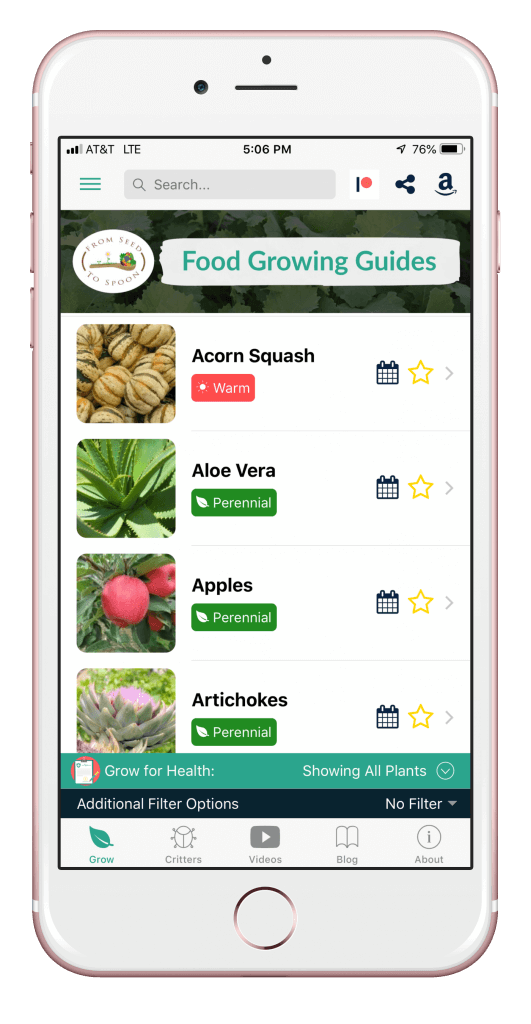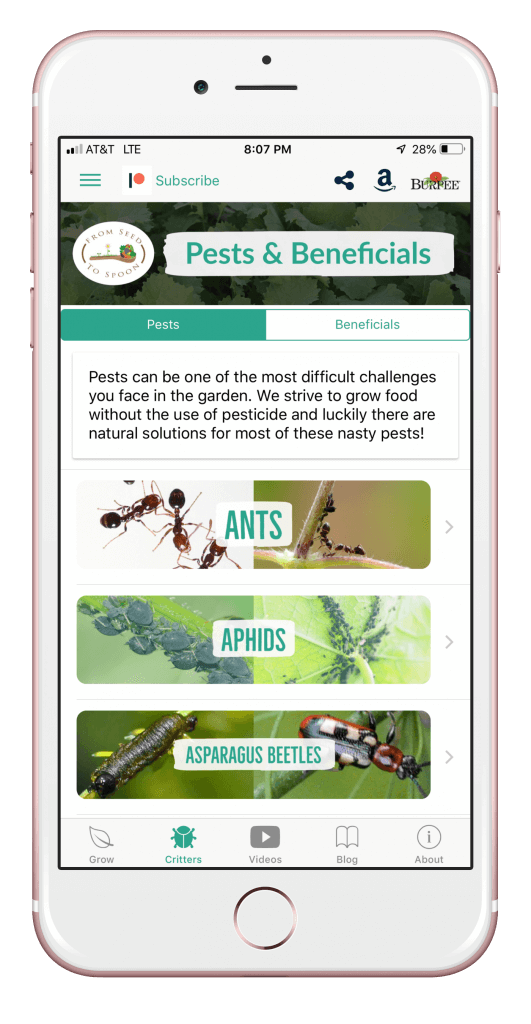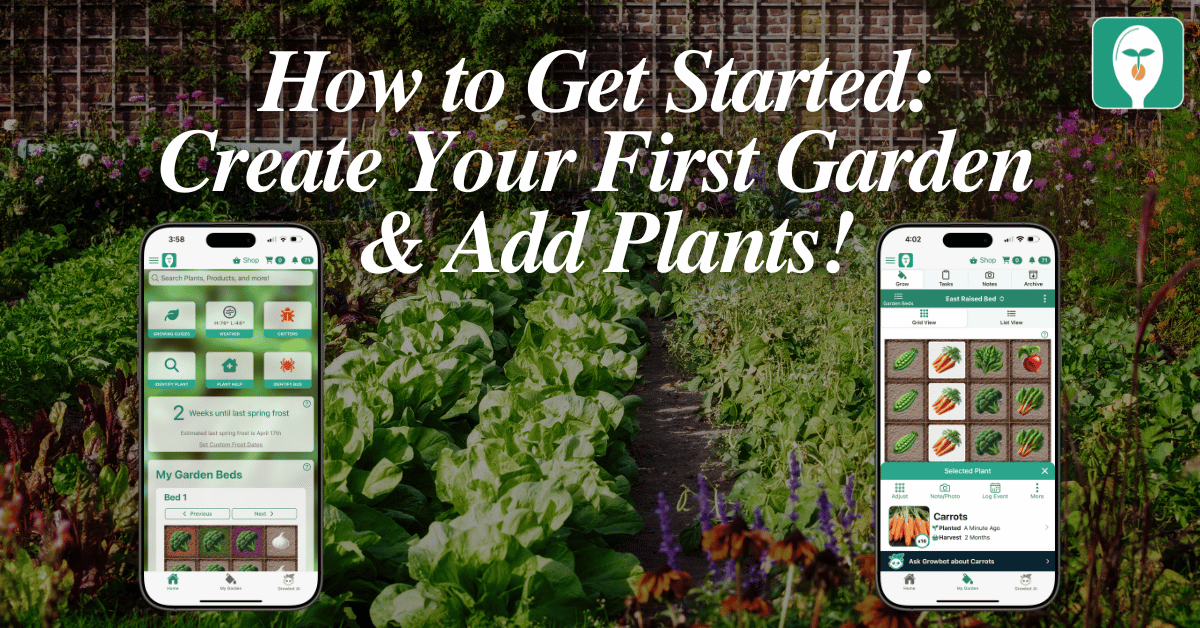
Treatment Options:
- Hand-pick (or pay your kids a quarter each to handpick for you like we do!)
- Cover the plants with insect netting (floating row covers) from when they are babies. This will help to prevent them from becoming an issue!
- Use the organic pesticide, BTK (bacillus thuringiensis Kurstaki). BTK is a naturally occuring microorganism that sickens and kills caterpillars without harming butterflies, bees, and other beneficial insects. There are varied opinions regarding the safety of BTK, but it’s classified as an organic treatment and is certainly safer than using a more toxic pesticide.

Cabbage worms are the caterpillar of a white butterfly with black wing tips and black spots. You can distinguish them from the cabbage looper by looking for faint yellow stripes on its back. The eggs are cone shaped, whitish-yellow, and laid on the underside of the leaves.
Treatment Options:
- Head-pick (or pay your kids a quarter each to handpick for you like we do!)
- Cover the plants with insect netting (floating row covers) from when they are babies. This will help to prevent them from becoming an issue!
- Use the organic pesticide, BTK (bacillus thuringiensis Kurstaki). BTK is a naturally occurring microorganism that sickens and kills caterpillars without harming butterflies, bees, and other beneficial insects. There are varied opinions regarding the safety of BTK, but it’s classified as an organic treatment and is certainly safer than using a more toxic pesticide.

Treatment Options:
- Cover the plants with insect netting (floating row covers) from when they are babies. This will help to prevent them from becoming an issue!
- Cardboard “collars” can be made from toilet rolls or paper towel rolls and placed around each seedling to keep these cutworms out. You can also place toothpicks around seedlings so the worm cannot wrap around the stem.
- Diatomaceous earth can also be laid down around your seedlings to help get rid of them.
- Sprinkling coffee grounds or crumbled egg shells can help repel them from your seedlings as well.

Treatment Options:
- The best thing to do is to build a fence at least 8 feet tall around the garden. There are a few other ideas that you can try, but this is the only guaranteed solution.
- Deer are supposed to be repelled by strong odors. You can place strong scented bar soap in the garden. Another odor you can use to repel them is the human scent. Try placing human hair around the perimeter of your garden.
- Setting up a motion-activated sprinkler can help scare them away as well. Try moving it around so your deer do not start to catch on to your trick!
- There are commercial deer repellents that are available made with all natural ingredients that are supposed to help deter deer from where it is placed.
- Applying blood meal around the perimeter of your garden can also be a help for deterring deer.

Treatment Options:
- Insect netting (floating row covers) provide the best form of protection against earwigs.

Treatment Options:
- Clear out any debris in your garden that grasshoppers can use for cover or laying eggs.
- Use your companion plants to your advantage! The garlic odor can help deter them. You can use a homemade garlic spray or plant garlic around where you have a problem.
- Beneficial critters can be very helpful with this pest as well! Praying mantis (purchase here) can be helpful to fight off grasshoppers. Birds can come to the rescue as well.
- Placing insect netting (floating row covers) over your garden is the best way to prevent grasshoppers from attacking your plants.
- Applying neem oil is also another option for treatment, but make sure not to apply when the temperature is above 90, or else you could suffocate your plant!

Treatment Options:
- Woodchucks are scared of larger predators. You can buy fox urine granules or animal repellent which helps to repel them. Along this same line, you can also go out and pee in your garden or collect your urine in your house. I know it sounds gross, but it does help to repel them!
- Setting out a small animal trap to catch them is an option.
- Setting up a motion-activated sprinkler can help scare them away.
- Cats and dogs are effective hunters of small rodents! Even just their smell and presence in the yard can help to keep them out of your gardens.

Treatment Options:
- The best treatment for nematodes is prevention! Practicing crop rotation from year to year is essential.
- Simply tilling the soil over multiple times throughout the fall and winter months can help to prevent these infestations.
- Adding in new organic matter (compost) when you replant helps to keep nematodes at bay.
- Burn & turn is a term used commonly to get rid of these types of pests in the soil. When your soil is empty of vegetative growth, turn your soil and use a flame thrower to burn the top layer of the soil. If you do not have a flame thrower you can use a dark color plastic sheet to cover over the summer months to heat the temperature of the soil up to a high enough temperature to kill the nematodes.

Treatment Options:
- Clear out any decaying matter in your garden, leaves, and fallen fruit or vegetables.
- Trellis plants that can be to get their fruit off the ground.
- Diatomaceous earth can be used to help prevent pillbug infestation.

Treatment Options:
- Placing an automated sprinkler to scare the rabbit away is helpful.
- Rabbits are scared of larger predators. Applying blood meal around the perimeter of your garden has been shown to deter rabbits. Rabbit repellent, fox urine granules, or even human hair and urine can help to deter them as well.
- You can also use a live animal cage trap to catch them.

Treatment Options:
- Nighttime hunts are the best way to go about finding these creatures! Hand-picking and placing the slugs or snails in a salty or soapy solution will ensure that they are killed.
- You can set beer out in shallow saucers to attract then drown your slugs.
- Diatomaceous earth can also be laid down around your garden to help get rid of them.

Treatment Options:
- The best way to prevent issues it to practice good crop rotation. Make sure to not plant vegetables of the same family in the same place each season. This should prevent them from becoming an issue.
- Tilling your soil each year will help to disrupt the breeding of these pests.
- Beneficial nematodes can also be purchased to help control wireworms.
Learn more about growing over 100 different foods, including how to manage various pests in our FREE iOS, Android, or Universal Web App!



Carrie Spoonemore, co-founder of “From Seed to Spoon,” stands as a beacon of inspiration for gardeners and health enthusiasts alike. Her journey alongside her husband, Dale Spoonemore, in creating a platform that demystifies gardening and promotes a healthier lifestyle, has made a significant impact on individuals around the globe. Through the “From Seed to Spoon” app, Carrie has dedicated herself to empowering people to take control of their health and environment by growing their own food.
With a profound belief in the power of gardening to improve mental and physical health, Carrie’s contributions to the Seed to Spoon blog reflect her holistic approach to wellness. Her articles often focus on the nutritional benefits of homegrown fruits and vegetables, organic gardening practices, and the mental health benefits of spending time in nature. Carrie’s expertise in health science shines through in her detailed discussions on how specific plants can contribute to a balanced diet and overall well-being.
Carrie’s passion for gardening is deeply intertwined with her commitment to family and community wellness. She frequently shares personal stories of how gardening has brought her family closer together, offering practical tips for involving children in gardening activities and making it a fun, educational experience. Her writing encourages families to explore gardening as a means of spending quality time together while learning about nature and sustainability.
In addition to gardening advice, Carrie’s contributions to the blog include insights into the use of technology to enhance the gardening experience. She has played a crucial role in designing the “From Seed to Spoon” app to be user-friendly, ensuring that users of all ages and backgrounds can navigate the complexities of gardening with ease. Her vision for the app is not just as a gardening tool but as a vehicle for change, inspiring individuals to adopt a more sustainable lifestyle by growing their own food.
Carrie Spoonemore’s presence on the blog is marked by her compassionate approach to teaching and her unwavering belief in the transformative power of gardening. Her work continues to inspire a community of gardeners to pursue a healthier, more sustainable way of living, proving that with the right tools and knowledge, anyone can become a gardener and advocate for their health and the planet.







